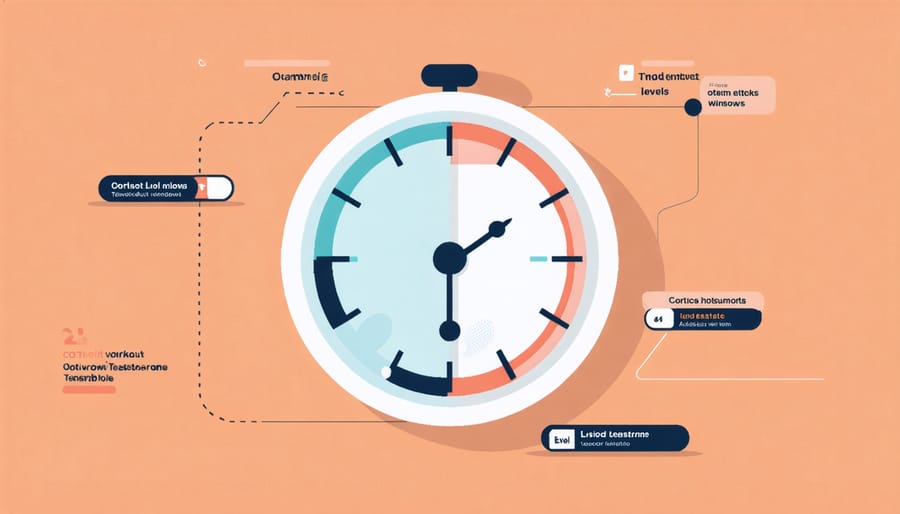Transform your nighttime routine into a muscle-building opportunity with strategic evening strength training. Research from the Journal of Sports Science shows that working out 2-3 hours before bedtime can actually enhance sleep quality while boosting strength gains. Your body’s core temperature peaks in the evening, making your muscles more flexible and potentially reducing injury risk during resistance exercises.
However, timing and technique matter significantly. Evening strength training requires specific adjustments to protect your sleep cycle and maximize benefits. The key lies in selecting the right exercises, managing workout intensity, and implementing proper post-workout recovery strategies. Whether you’re a busy professional seeking efficiency or someone looking to optimize their training schedule, evening strength sessions can fit seamlessly into your lifestyle when done correctly.
This guide explores science-backed methods to harness the unique advantages of nighttime strength training while ensuring you maintain healthy sleep patterns and recovery cycles.
The Benefits of Nighttime Strength Training

Hormonal Advantages
Evening strength training may offer unique hormonal advantages that support your fitness goals. Research shows that testosterone levels naturally peak in the evening hours, which can enhance the biological muscle growth process. This natural rhythm aligns well with strength training, potentially maximizing your body’s ability to build and maintain muscle mass.
Growth hormone, another crucial component for muscle development and recovery, also shows increased activity during evening hours. This hormone surge typically begins in the early stages of sleep, making evening workouts strategically timed to take advantage of this natural boost.
However, it’s important to note that these hormonal benefits vary from person to person. While some may experience enhanced performance and better muscle gains from evening workouts, others might find their sweet spot at different times of the day. The key is to maintain consistency with your chosen workout time and ensure you’re allowing enough wind-down time before sleep to maintain good sleep quality.
Remember that these hormonal advantages are just one factor to consider when planning your workout schedule. Your personal schedule, energy levels, and sleep patterns should also guide your decision.
Peak Muscle Performance
Research shows that our body temperature naturally rises in the evening hours, potentially leading to enhanced muscle performance. This temperature increase, which typically peaks between 4:00 PM and 6:00 PM, can contribute to better muscle strength, flexibility, and power output during evening workouts.
Studies have found that muscle strength tends to be about 5-10% higher in the evening compared to morning hours. This improvement is linked to optimal body temperature and circadian rhythm patterns that affect muscle function. Your muscles are naturally warmer and more pliable during these hours, which can lead to better performance during strength training exercises.
Evening strength training may also benefit from increased testosterone levels later in the day, though individual hormone patterns can vary. The combination of higher body temperature and hormone levels creates a favorable environment for muscle growth and strength development.
However, it’s important to note that these benefits don’t necessarily mean everyone should switch to evening workouts. Your personal schedule, energy levels, and sleep patterns should guide your workout timing choice.
Optimizing Your Evening Workout
Timing Your Workout
Research suggests that the ideal window for strength training before bed is between 2-3 hours prior to your planned bedtime. This timing allows your body temperature and heart rate to return to normal levels, promoting better sleep quality. For example, if you typically go to bed at 10:30 PM, aim to complete your workout between 7:30 and 8:30 PM.
While some people can exercise closer to bedtime without issues, working out too late may interfere with your sleep. Exercise increases adrenaline and core body temperature, which could make it harder to fall asleep if you don’t allow enough cooling-down time. The post-workout increase in endorphins might also keep you feeling energized when you should be winding down.
If your schedule only permits later workouts, try to finish at least 90 minutes before bed. This minimum window gives your body time to transition from an active state to a more restful one. Remember to keep the intensity moderate and include proper cool-down exercises to help your body prepare for sleep.
Listen to your body’s responses and adjust your workout timing accordingly. Some people might need more time to wind down, while others can exercise closer to bedtime without sleep disruption.

Exercise Selection
When selecting exercises for evening strength training, focus on compound movements that engage multiple muscle groups while maintaining a moderate intensity level. Understanding strength training fundamentals is essential for creating an effective nighttime routine.
Choose exercises that don’t overly stimulate your nervous system. Body weight exercises like squats, lunges, and push-ups are excellent options, as they allow better control over intensity. If using weights, opt for controlled movements with moderate resistance rather than explosive or maximum-effort lifts.
Recommended evening exercises include:
– Bodyweight squats
– Modified push-ups
– Dumbbell rows
– Walking lunges
– Glute bridges
– Wall planks
– Controlled shoulder presses
– Romanian deadlifts with light weights
Aim to work at about 60-70% of your maximum effort. This intensity level provides enough stimulus for strength gains while avoiding excessive arousal that might interfere with sleep. Keep repetitions in the 8-12 range per set, focusing on proper form and controlled breathing.
Avoid exercises that require spotters or could be dangerous when fatigued. Also, skip Olympic lifts or heavy powerlifting movements that demand high concentration and nervous system engagement. Instead, emphasize exercises that promote muscle tension while maintaining a steady, manageable pace.
Remember to listen to your body and adjust the intensity based on how you feel. Some days may call for lighter weights or fewer sets, especially if you’re feeling particularly tired.

Post-Workout Sleep Strategies
Cool-Down Routine
A proper cool-down routine is essential for transitioning your body from an active state to rest mode, especially when strength training before bed. Start by gradually reducing the intensity of your movements with 5-10 minutes of light exercises like walking in place or gentle stretching. This helps lower your heart rate and body temperature naturally.
Focus on relaxation-promoting stretches that target the major muscle groups you’ve worked. Hold each stretch for 15-30 seconds while taking deep, controlled breaths. Pay special attention to your shoulders, back, and legs. These post-workout recovery strategies help prevent muscle tension and promote better sleep quality.
Consider incorporating gentle mobility exercises like arm circles, ankle rotations, and hip openers. These movements help release any remaining tension while promoting circulation. End your cool-down with 2-3 minutes of deep breathing exercises, focusing on long exhales to activate your parasympathetic nervous system – your body’s natural relaxation response.
Avoid rushing through your cool-down routine, as this transition period is crucial for preparing your body for sleep. Keep the lighting dim and maintain a quiet environment to help signal to your body that it’s time to wind down for the night.
Nutrition Timing
Proper nutrition timing after your evening workout can significantly impact both your recovery and sleep quality. To support muscle recovery while promoting restful sleep, aim to eat within 30 minutes after completing your strength training session.
Your post-workout meal should include a balanced combination of protein and complex carbohydrates. Protein helps repair and build muscle tissue, while carbohydrates replenish energy stores and can support the production of sleep-promoting hormones like serotonin.
Good evening post-workout meal options include:
– Greek yogurt with berries and granola
– A banana with natural peanut butter
– Whole grain toast with eggs
– Oatmeal with protein powder and fruit
Avoid heavy, high-fat meals as they can cause discomfort and disrupt sleep. Similarly, steer clear of caffeine-containing foods and beverages in the evening hours. If your workout ends close to bedtime, opt for a lighter snack rather than a full meal.
Stay hydrated but try to complete most of your water intake at least two hours before bed to minimize nighttime bathroom visits. Consider including foods rich in magnesium and tryptophan, such as nuts, seeds, and dairy products, which can naturally support better sleep while aiding in muscle recovery.
Remember that individual tolerances vary, so pay attention to how different foods affect your sleep quality and adjust accordingly.
Strength training before bed can be a viable option for many Canadians, particularly those with busy daytime schedules. When done correctly, evening workouts can offer numerous benefits while maintaining good sleep quality. The key is to follow proper guidelines and listen to your body’s responses.
Remember to keep your workout intensity moderate and finish at least 90 minutes before bedtime to allow your body temperature and heart rate to return to normal levels. Focus on controlled movements and proper form rather than lifting maximum weights late in the day. This approach helps reduce the risk of injury while still providing effective strength gains.
If you choose to exercise in the evening, maintain good sleep hygiene by following a consistent bedtime routine, keeping your bedroom cool and dark, and avoiding screens immediately after your workout. Stay hydrated but try to complete most of your fluid intake during the workout to prevent nighttime bathroom visits.
For optimal results, consider starting with two to three evening sessions per week and adjust based on how your body responds. Pay attention to your sleep quality and energy levels the following day. If you notice any negative impacts, try moving your workout earlier or reducing the intensity.
The most important takeaway is that evening strength training can be beneficial when properly executed. Don’t let concerns about nighttime exercise prevent you from maintaining a consistent fitness routine. With proper planning and attention to your body’s signals, you can successfully incorporate strength training into your evening schedule while maintaining quality sleep and overall health.
Take the first step by starting gradually and adjusting your routine based on your personal experience. Remember, the best workout schedule is one that you can maintain consistently and that fits your lifestyle while supporting your health goals.

